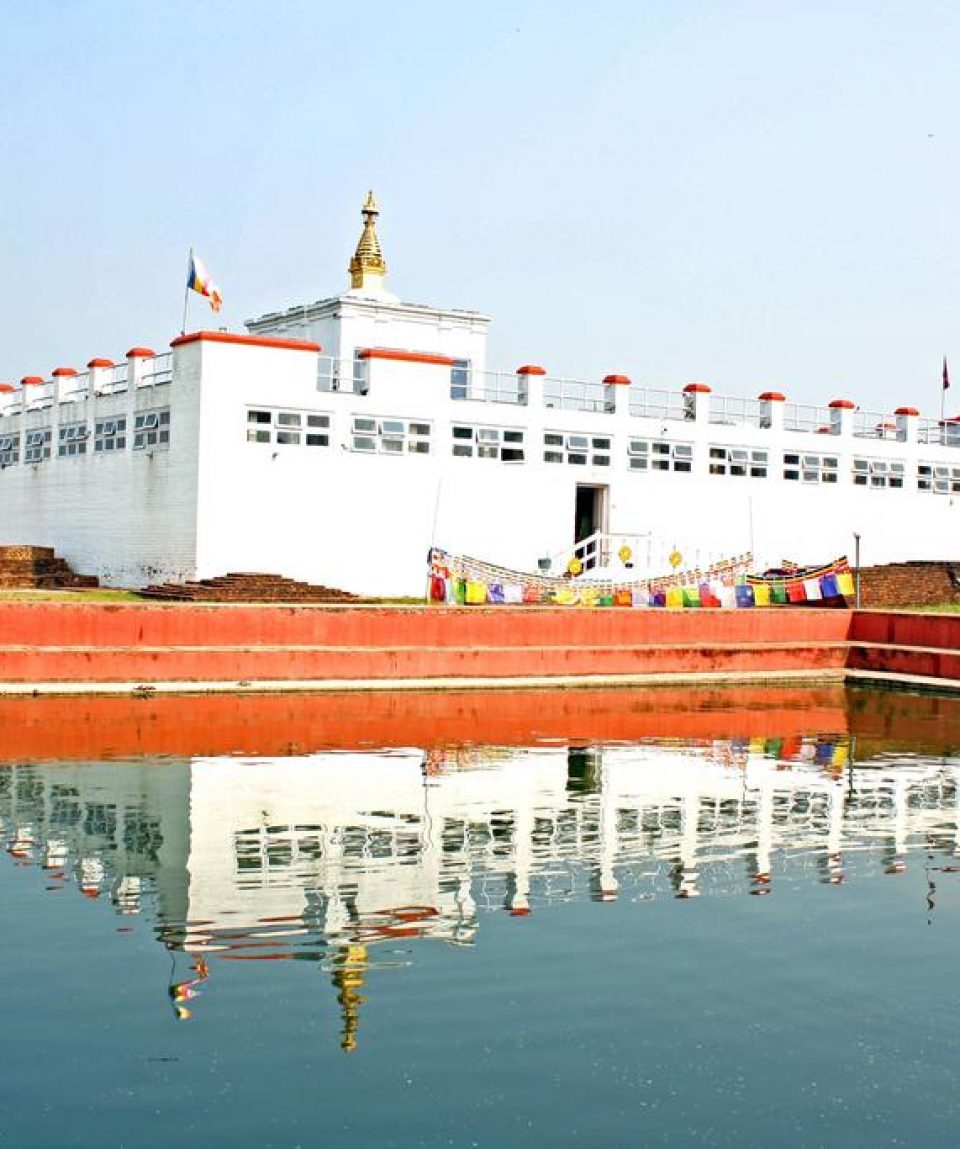Lumbini
Lumbini, Nepal is the birth place of Lord Buddha, Siddhartha Gautama. Today you can still see ruins and the exact spot of his birth marked and enclosed by a temple. The tank next to the Maya Devi temple is said to be where his mother bathed before delivering the miraculous baby, born walking and talking. Lumbini is also a UNESO World Heritage Site where you can observe a diverse range of ethnic communities sharing their rich history, culture and traditions with the outside world.
Siddhartha Gautama, the Lord Buddha, was born in 623 B.C. in the famous gardens of Lumbini, which soon became a place of pilgrimage. Among the pilgrims was the Indian emperor Ashoka, who erected one of his commemorative pillars there.
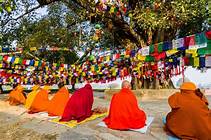
-
Reviews 0 Reviews0/5
-
Vacation Style Holiday Type
-
Culture
-
-
Activity Level Fairly Easy
-
Mayadevi Temple is the most sacred site in the Lumbini Garden where archaeologists have identified the exact spot where Lord Buddha was born. Inscriptions on the Ashoka Pillar nearby also refer to the spot as his birthplace. It is said that the newly born Prince Siddhartha (later became the Buddha) took his first seven steps and delivered his peace message to humanity here.
The Lumbini Garden covers an area of 2.56 sq. km or 1 x 3 sq. miles and encompasses three zones, each covering one square mile connected with walkways and a canal. The area has a sub-tropical climate with hot summers, very wet monsoon and pleasant winter. Winter is the best time to visit.
Place to Visit Around Lumbini
Maya Devi Temple is recognized throughout the world as the place where Queen Maya Devi gave birth to Gautama Buddha- the founder of Buddhism. For this reason, Maya Devi Temple stands out as the spiritual heart of Lumbini next to a scared pond called Pushkarni. Spending your day exploring the ancient ruins of temples and palaces around the holy Maya Devi Temple is rated by many visitors as the most popular thing to do in Lumbini Nepal.
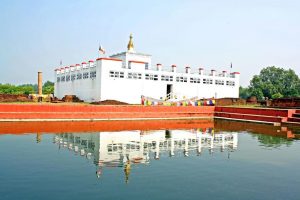
One of the most ancient Buddhist Temples in Lumbini, which is also a UNESCO World Heritage Site, Maya Devi Temple is one of the most well-known temples which is known as the birthplace of Gautam Buddha. The temple is situated in the middle of the park grounds called Lumbini Development Zone, its continuous developments making it a must-visit attraction.
The Bodhi Tree in Lumbini is located in the premises of the Maya Devi Temple complex right next to the shrine on the banks of the serene Maya Devi Pond. Buddhist monks often sit under the tree meditating and chanting spiritual scripts. The tree is an age-old Pipal tree or Focus Religious clad in colorful prayer flags, Locals believe that wishes made while tying a colorful prayer flag are often granted.

Located right in front of the Maya Devi Temple in Lumbini, Maya Devi Pond is a square-shaped structure with steps all around to ascend to the water level. Also known as Puskarini, this is where Gautama Buddha’s mother – Maya Devi – used to bathe. In fact, Lord Buddha’s first bathing was done in this pond. A grand temple now takes the location where Buddha was born, and the Maya Devi pond is located right in front of the shrine. On special occasions, the steps around the pond are illuminated with oil lamps after sundown to worship the sacred place.
The Ashoka Pillar in Lumbini is one of the 3rd Century stone pillars built under the reign of Emperor Ashoka. It was erected as a mark of respect by Ashoka after he visited Lord Buddha’s place of birth and decided to accept Buddhism. These facts make the pillar a significantly important attraction in the country. It bears the oldest inscription compared to the rest of the Ashoka Pillars, thus marking that it was the first-ever such structure built. The pillar is located inside the serene Maya Devi Temple complex and is quite a stimulating structure to visit because of its interesting and motivating history. This 6-metre tall pink sandstone structure was rediscovered by Nepalese archaeologists in 1896.
At the northernmost the site is the World Peace Pagoda. It was built by Japanese Buddhists as a symbol to unite humanity. It’s an enormous pagoda that dazzles bright white in the sun. True to the name, you’ll often find locals sitting peacefully in the park around it with a picnic. You can also climb up the stairs and walk around the upper level of the pagoda.
Japan Peace Stupa, also known as World Peace Pagoda is an early 21st Century monument – a symbol of peace and a famous tourist attraction in Lumbini. Located outside the main compound, the structure is a glorious stupa with traditional pagoda style architecture. Constructed by Japanese Buddhist at a cost of US $1 million, the monument is colored white with a golden buddha statue.
Lumbini is world renowned for its relationship with Buddhism, and Lumbini Museum only reinforces that association with its wide range of pictures and artifacts from Buddhist sites all over the world. Other significant exhibits include metal sculptures and stamps of Lumbini from around the world, including Buddhist manuscripts. It is an institution dedicated to the life of Buddha, and is the perfect place to gain some extra insight into Buddhist traditions.
Located inside the UNESCO World Heritage Site of Sacred Garden Area, Lumbini Museum displays about 12000 artifacts including religious manuscripts, metal sculptures, Terra cottas, coins from Maurya and Khusana dynasty and stamps from all over the world depicting Lumbini. Lumbini International Research Institute (LIRI), located opposite the Lumbini Museum, provides research facilities for the study of Buddhism and religion in general. This museum was built in the 1970s and is now reimagined by architect Kris Yao from Taiwan and his team.
Royal Thai Monastery in Lumbini is an imposing and stunning wat-style (Thai Monastery style) monastery dedicated to Buddhist practices. The gleaming building is constructed from white marble and the blue-roofed meditation center close by are an example of a fine architectural style. The beautiful designs and carving on the temple wall make this place a must-visit.
Dharma Swami Maharaja Buddha Vihar is a Buddhist Gompa belonging to the Sakyapa order. It was established by His Eminence Chogya Trichen Rinpoche. The immense peace and tranquility of the site makes it a perfect place for meditation and quiet introspection. Every day, Tara Pooja is performed by the 60 monks residing in the monastery.
Also known as Sri Lanka Temple, the monastery is a beautiful Sri Lankan Buddhist establishment that give insights into the life of Gautama Buddha and its importance in the region. The grand monastery holds several important religious events and practices, especially those followed in Sri Lanka. These celebrations, events, and festivals may seem a little different than those followed in an ancient monastery in Lumbini. However, the motive and the teachings are almost the same. It also provides a sneak peek into the life of Gautama Buddha and emphasizes on its evolution throughout time. The Sri Lankan Monastery in Lumbini is a perfect illustration of a system of spiritual belief bringing two countries closer. Those wanting to explore the association must visit the monastery.
Cambodian Monastery in Lumbini is an amalgamation of colorful fantasy and spiritual forces making it one of the most fascinating temples in the region. Built in an architectural design matching the famous Angkor Wat, the charming monastery is surrounded by a square railing, each having four 50m green snakes. The large compound has an outer wall covered with beautiful and intricate designs.
After exploring famous touristic places of Lumbini, you can head to Myanmar Golden Monastery. It is a place well-suited for those people who want to immerse themselves in the cultural and spiritual vibe without going too far away from the central touristic areas of Lumbini. Going here is a famous thing to do in Lumbini Nepal.
Myanmar Golden Temple in Lumbini is the oldest structure of the city. Built in Burmese style of architecture, the temple is dedicated to Lord Buddha. The impressive corncob-shaped shikhara, styled after the temples of Bagan gives a regal look to the whole structure. There are three prayer halls and a Lokamani Pula Pagoda inside the building.
Zhong Hua Chinese Buddhist Monastery, popularly known as the China Temple is an elegant Buddhist Monastery in Lumbini. The impressive structure is built in a pagoda-style of architecture and resembles the look of the famous forbidden city of China. As one enters, the perfectly manicured internal courtyard fills the heart with peace and joy.
All of the monasteries inside Lumbini have their own unique quirkiness made up of strong religious beliefs. The feeling of excitement as you make your way into Dae Sung Shakya or Korean Temple is something that will brighten your whole day. Here you can find many interesting things to do in Lumbini Nepal.
Dae Sung Shakya Sa, popularly known as the Korean Temple, is a Buddhist Monastery in Lumbini. The impressive structure is built in a Korean style of architecture and has colourful murals on the ceiling. It even offers community sleeping area as well as three meals a day to visitors for a few days at a minimal cost of NOR 500 per day. Meditating in the courtyard full of monks and pilgrims is a peaceful and refreshing experience.
Located at a distance of 29 km from Lumbini, Tilaurakot houses remains of Kapilavstu and is considered to be the place where Lord Gautama Buddha spent 29 years if his life. Its unearthing is marked as a significant event that reveals the historical life of Gautama Buddha.
Lumbini Monastic Site is a complex housing various temples and monasteries maintained to give insights into the life of Gautama Buddha, to help understand the importance of Buddhism, its propagation, evolution and the system of belief that acts as a common string to help maintain harmonious associations between several countries. The region is completely free from commercialization and has no shops or hotels and restaurants. The Monastic Site is divided into two sections by a water canal which is often used by tourists to explore on motor boats. The eastward section is called the East Monastic Zone, where Theravada Buddhism is prevalent, and the westward zone is called the West Monastic Zone, where Vajrayana and Mahayana are predominant. Once inside, one is only in touch with the culture, traditions and the history of Buddhism.
Cranes hold a special place in the tales related to Buddha. So naturally, they have been devoted a sanctuary, dedicated entirely to their preservation, which also serves as a conservation site to a lot of other local birds. Located close to the World Peace Pagoda, it is estimated that there are over 100 pairs of cranes living in the reserve, including the rare species of Sarus Crane.

Lumbini Garden in Nepal, the birthplace of Siddhartha Gautama (the Buddha) and an important Buddhist Pilgrimage site is now a sanctuary for cranes. This sanctuary is spread over the area of 6 square kilometers and consists of the ruins of the palace of Tilaurakot where Siddhartha Gautam spent 29 years of his life. It is one of the most unique attractions in Nepal and is definitely worth a visit.
A chorten created by Buddhists from Manang in Northern Nepal, the Manang Samaj Stupa is known to be one of the oldest Stupas in Nepal, dating back to the birth of Gautam Buddha in 600 BC. There is a golden Buddha Statue in the middle of this building and is surrounded by colourful murals. At present, this attraction is believed that it will go under renovation soon.
Situated in Lumbini, Vietnam Phat Quoc Tu Temple is one of the few attractions that represent the relationship between Vietnam and Nepal. A number of people visit this temple as part of the pilgrimage for Gautam Buddha. With its facade flanked with artificial mountains and a grand roof, it is definitely worth a visit for those who are interested in Buddhism and are visiting Lumbini.
Great Drigung Lotus Stupa is one of the most religiously important Stupas in Lumbini and was built by the German Tara Foundation. The building contains a hollow crown partly covered in glass which reveals the Buddha statue inside. The historical significance of this building goes back centuries when the construction of this building was under the supervision and guidance of the Rinpoches. This Stupa is definitely worth a visit when in Lumbini.
Thrangu Vajra Vidya Monastery is a monastery in Lumbini that is dedicated to Thrangu Rinpoche. He believed in the teachings of Buddha, building his principles on peace, knowledge and unity. This monastery is one of the institutions established by him and is one of the few that actively support education in Nepal. From a very young age, Thrangu Rinpoche started establishing institutes for Buddhist studies. Today, this monastery has a number of students who are aspiring monks.
Tourists spending their vacation in Lumbini surely would not want to miss out on the chance of seeing the intriguing ‘Eternal Peace Flame’ which fascinates the eyes of every first-time visitor. Eternal Peace Flame is located at the center of Lumbini Garden. Heading to Eternal Peace Flame is widely known to be a joyous occasion for those wanting to experience a cool thing to do in Lumbini Nepal.
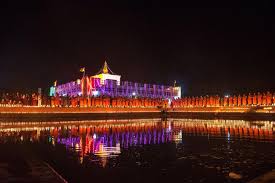
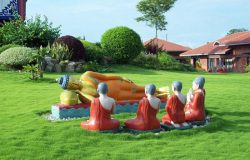
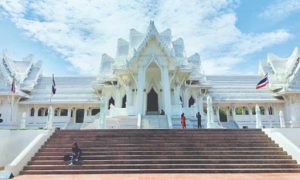
Things to Do
- Explore Monasteries
- Try Street Foods
- Rent a Bicycle and Explore Rural Terrain
- Take Meditation Classes
- Explore Maya Devi Temple and Meditate Under the Bodhi Tree
The heritage site in Lumbini forms the main attraction of the city, with religion and archaeology lovers alike flocking to the locales that carry some of the best spiritual landmarks in the country. Located around 265 km from Kathmandu, Lumbini may appear to be situated a little out of the way for tourists doing the full circle around Kathmandu Valley. So here, we have compiled a comprehensive guide on some of the most convenient ways to reach Lumbini.
By Air
Lumbini does not yet have an international airport, so for people traveling to Nepal from international destinations, their best option is to break their journey at Tribhuvan International Airport in Kathmandu. After landing in Kathmandu, you can choose to cross the rest of the distance to Lumbini via road or catch another internal flight.
The closest domestic airport from Lumbini is the Siddhartha Gautam Airport in Bhairawaha, which is 22 km away from Kathmandu. A connecting flight from Kathmandu to Bhairawaha takes around 30 minutes. The only airlines that operate between the two cities are Buddha Air and Yeti Airlines. A 15-minute drive from Bhairahawa Airport will take you to your final destination of Lumbini. The Government of Nepal has announced the opening of an international terminal in the Siddhartha Gautam Airport, Bhairahawa in June 2019; this measure is set to make traveling to Lumbini a much easier prospect for all.
By Road
After landing in Kathmandu, if you decide to take the road route to cover the rest of your journey to Lumbini, you can catch a bus from Kalanki Bus Station in Kathmandu to Lumbini Chowk or Buddha Chowk, and then take another bus or cab from there to Lumbini Bazaar. Alternatively, you can also choose to get to Bhairahawa first from Kathmandu, and then travel to Lumbini from here. People opting to fly in to Bhairahawa Airport from Kathmandu can take a bus or taxi to Lumbini that is located only 26 km away from the airport.
The closest border crossing from Lumbini is Sunauli, which is located around 30 km away. People coming in from Gorakhpur and Varanasi in India first arrive at the Sunauli border before moving on to Lumbini. After reaching Sunauli, you can take a rickshaw to Buddha Chowk; here, you will find buses queuing up to take you to Lumbini Bazaar. You will also find private taxis for hire here, which are a costlier but convenient affair.
Upon getting to Sunauli, some people may also choose to catch a ride to Bhairahawa first, and then catch a bus from Bhairahawa to Lumbini. On the Indian side of the border, buses also run from Gorakhpur and Varanasi to Sunauli crossing. People who take a bus to Lumbini from Pokhara or Chitwan are also dropped off at Buddha Chowk first, and can then catch another bus to Lumbini Bazaar directly.
A lot of travel agents will claim to take you through routes that reach Lumbini directly or through shorter routes and probably charge you a lot of money for the same. Caution should be practiced at such times since every route to Lumbini involves some kind of connecting stop or vehicle change, and at the moment there are no direct routes to the town.

